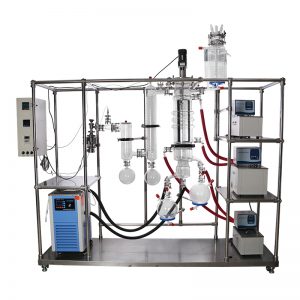The distillation is a kind of thermodynamic separation process. It can evaporate components with low boiling points by utilizing that the boiling point of each component in the mixed liquid or liquid-solid mixture is different, and then condense the material to separate the whole components. It is the combination of evaporation and condensation unit operations. So what is molecular distillation?

Definition of Molecular Distillation
The molecular distillation is a kind of distillation technology carried out under a high vacuum. In this case, the average free path of steam molecules is greater than the distance between the evaporation surface and the condensation surface. Hence, the liquid mixtures can be separated by utilizing the difference of the evaporation rate of each component in the liquid.
Features of Molecular Distillation
- Low distillation temperature. The molecular distillation is operated at a temperature much lower than boiling points. The separation can be achieved as long as there is a temperature difference. It is the essential difference between the molecular distillation and conventional distillation.
- High vacuum degree of distillation. The quite high vacuum degree can be obtained inside the molecular distillation apparatus. The molecular distillation is generally performed at a very low pressure, so that the material isn’t easily damaged by oxidation.
- The liquid film of distillation is thin with a high efficiency of heat transfer.
- The short heating time for materials can reduce possibilities of thermal decomposition of materials.
- Higher degree of separation. The molecular distillation can separate substances that are normally difficult to be separated.
- There is no boiling bubble phenomenon. As a free evaporation on the surface of liquid layer, the molecular distillation can be operated under low pressure without dissolved air in the liquid. Thus there is no bubble phenomenon due to it can’t make the whole liquid boil in the distillation process.
- Without toxic, damage, pollution and residual, the pure and safe product can be obtained by simple operation processes and less equipment. The molecular distillation can separate substances that are normally difficult to be separated.
- The molecular distillation equipment is expensive. It must ensure that the system pressure can reach a high vacuum degree. It has relatively high requirements for material sealing, and the evaporation surface and the condensing surface should be moderate. The equipment is difficult to process and the cost is high.
- The product has a low energy consumption. The molecular distillation can lose less heat throughout the separation process. With a unique structural form, the internal pressure in the molecular distillation apparatus is extremely low and the internal resistance is much smaller than that of conventional distillation. Thus the energy consumption can be greatly reduced.
Advantages of Molecular Distillation
- The molecular distillation provides the best separation method for high boiling point, heat sensitive and easily oxidized materials. Because the molecular distillation can be operated under a temperature much lower than boiling points of materials and the retention time of materials is short.
- The molecular distillation can effectively remove substances in the liquid, such as organic solvent, odor, etc. It is a very effective method for the liquid desolvation after solvent extraction.
- The molecular distillation can distill out the desired product selectively as well as remove other impurities. More than two components can be separated at the same time by multistage separation.
- The fractional distillation is a physical process, which can protect the separated components well from contamination and damage.
[title text=”RELATED pRODUCTS” tag_name=”h2″ color=”rgba(32, 163, 219, 0.81)”]
[ux_products columns=”2″ ids=”973,2421″]
[title text=”Related Posts” tag_name=”h2″ color=”rgba(32, 163, 219, 0.81)”]
https://www.rotovap.cn/rotary-evaporator/4500.html